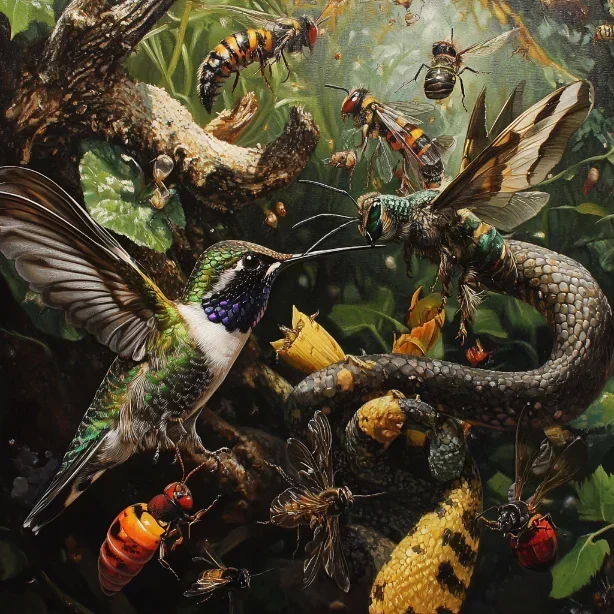(Or: How Nature’s Smallest Birds Outsmart Their Biggest Threats)
In the wild drama of survival, hummingbirds might seem like nature’s ultimate underdogs. Weighing less than a penny and smaller than many insects, these tiny warriors face a world of predators that would make anyone nervous. Yet through a combination of speed, smarts, and what can only be described as aerial acrobatic genius, they’ve mastered the art of staying alive.
Let’s start with some survival statistics that would impress any security expert:
- Escape speeds up to 50 mph
- Reaction times faster than most predators
- Aerial maneuverability that defies physics
- 360-degree head rotation capability
- Built-in early warning systems
The Threat Gallery
These diminutive birds face an impressive array of would-be predators. From the air, ground, and even lurking in flowers, danger can come from any direction. It’s like living in an action movie where everything is trying to eat you.
Primary predators include:
- Large insects (praying mantises, robber flies)
- Small raptors (sharp-shinned hawks, merlins)
- Domestic cats
- Tree-climbing snakes
- Even frogs and fish for low-flying individuals
The Speed Defense
When it comes to avoiding predators, hummingbirds have turned speed into an art form. Their primary defense is simply being too fast to catch, like a tiny feathered version of a fighter jet.
Speed-based defenses include:
- Lightning-quick directional changes
- Instant acceleration capability
- Backwards flight expertise
- Vertical escape patterns
- What amounts to natural afterburners
The Stealth Game
Sometimes the best defense is not being noticed in the first place. Hummingbirds have mastered the art of strategic invisibility when needed.
Stealth tactics include:
- Camouflaged nesting locations
- Silent flight capabilities
- Strategic freeze responses
- Understanding of sight lines
- Expert use of natural cover
The Warning System
Hummingbirds maintain sophisticated threat detection systems that would make military radar operators jealous.
Alert mechanisms include:
- Nearly 360-degree vision
- Vibration detection
- Sound pattern recognition
- Movement tracking
- Community warning calls
The Combat Arsenal
When stealth and speed aren’t enough, hummingbirds aren’t afraid to fight back. These tiny warriors pack surprising defensive capabilities.
Defense mechanisms include:
- Sharp bill jabbing
- Aerial dive bombs
- Intimidation displays
- Strategic positioning
- Coordinated group defense
The Social Shield
There’s safety in numbers, and hummingbirds have learned to use social dynamics to enhance their survival chances.
Social defenses include:
- Group vigilance
- Shared warning systems
- Coordinated predator response
- Territory overlap during threats
- Temporary alliances
The Nest Protection Game
Protecting their nests requires special strategies, as they can’t simply rely on speed when defending their young.
Nesting defenses include:
- Camouflaged nest construction
- Decoy flight patterns
- Strategic nest placement
- Distraction techniques
- What amounts to aerial guerrilla warfare
The Intelligence Factor
Perhaps their most impressive defense is their ability to learn and adapt to new threats. These birds prove that brain size doesn’t determine survival smarts.
Learning adaptations include:
- Predator pattern recognition
- Threat assessment skills
- Environmental awareness
- Strategy modification
- Experience-based improvements
The Urban Adaptation
As human environments expand, hummingbirds have developed new strategies for dealing with modern threats.
Urban survival skills include:
- Window collision avoidance
- Artificial light navigation
- Human activity patterns recognition
- Pet awareness
- Man-made structure utilization
The Future Challenge
As environments change, hummingbirds continue to evolve their defensive strategies to meet new threats.
Emerging adaptations include:
- Novel predator recognition
- Climate change responses
- Urban environment mastery
- New nesting strategies
- Advanced warning systems
Conclusion: Nature’s Tiny Warriors
The defensive capabilities of hummingbirds represent one of nature’s most impressive examples of how size doesn’t determine survival success. These tiny warriors have turned their apparent disadvantages into strategic advantages.
Remember: When you see a hummingbird zipping confidently around your garden, you’re watching a master of survival whose defensive capabilities would impress any military strategist.
Post Script: Some researchers suspect hummingbirds actually enjoy showing off their defensive moves. The birds maintain their tactical silence on this matter, but their seemingly unnecessary aerial displays suggest they might take pride in their security systems.


